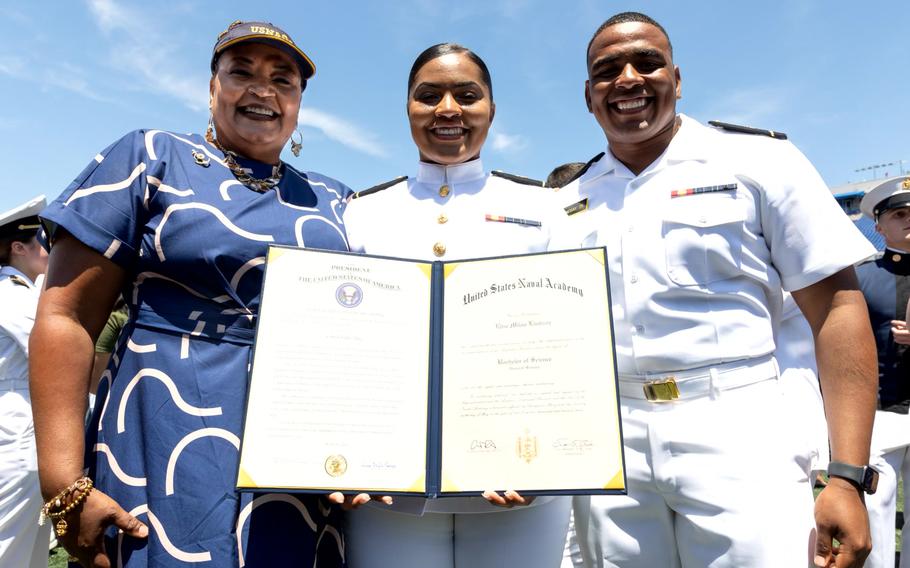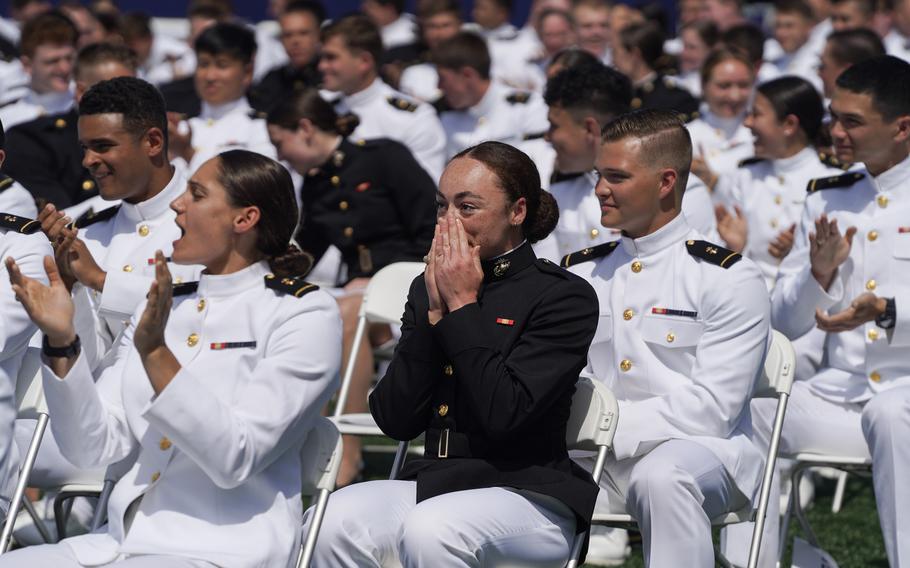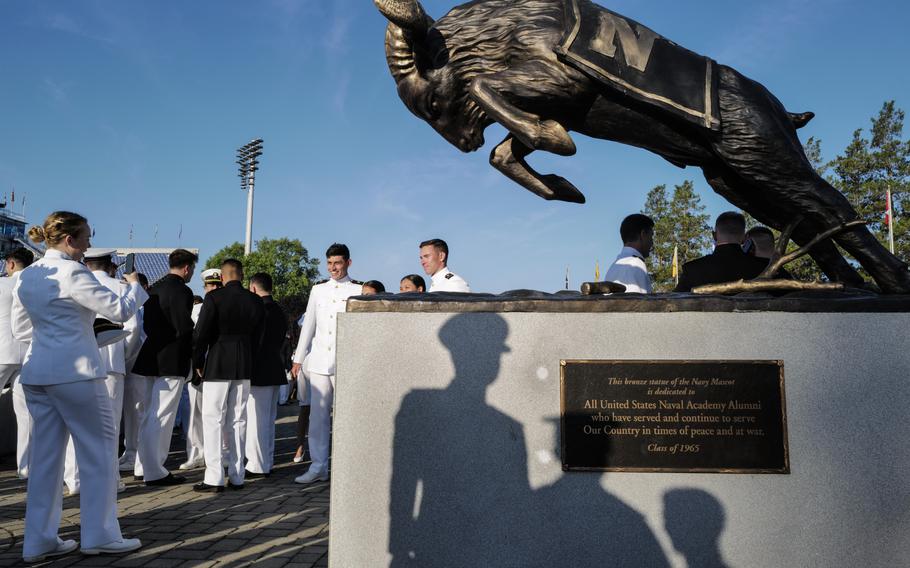
Retired Navy Capt. Timika Lindsay, left, and her daughter, Ensign Elise Lindsay, celebrate at the Naval Academy last month, along with her son, Midshipman Eric Lindsay, who’s set to graduate in 2025. (Kelly Eskelsen/Naval Academy Alumni Association and Foundation)
The nation’s military service academies now enroll far more people of color than they did at the turn of the century, as administrators seek future officers who will reflect the diversity of the forces they will lead and the country they defend.
The share of cadets at the U.S. Military Academy in West Point, N.Y., who identify with a racial or ethnic minority group ramped up from 20 percent in 2000, according to federal education data, to 36 percent in 2021. That minority share of midshipmen at the U.S. Naval Academy in Annapolis, Md., rose in that time from 19 percent to 37 percent. Similar trends held at the Air Force and Coast Guard academies.
But the Supreme Court could soon prohibit what the Biden administration calls a vital element of this transformation: a policy allowing colleges to consider race in the selection of an entering class. The court is weighing whether to ban race-conscious admissions in cases involving Harvard University and the University of North Carolina at Chapel Hill. A ruling is expected within a few days or weeks.
More than 30 prominent retired generals and admirals argue in an amicus brief that the court should uphold the race-conscious policies. Just as diversity matters on college campuses, they say, it matters within military leadership.
“It’s a key aspect in creating a trust relationship with our client, the American people,” said retired Army Lt. Gen. Robert L. Caslen Jr., the superintendent at West Point from 2013 to 2018, who joined the brief. “It makes you a lot stronger organization — more tools, more talents. … We’re not lowering standards whatsoever.”
At the Naval Academy in the fall of 2021, about 13 percent of midshipmen were Latino, 10 percent multiracial, 8 percent of Asian descent, and 6 percent Black or African American.

Naval Academy graduates during their May 26, 2023, commissioning ceremony in Annapolis, Md. Midshipman Caitlin Doran, center, was headed for assignment as a second lieutenant in the Marine Corps. (Michael Robinson Chávez/The Washington Post)
“Everyone just kind of gets thrown in a room with people from diverse cultures and races, and they’re forced to just kind of live together, and you’re forced to work together,” Midshipman Jason Hainze, 22, of Seattle said late last month at the academy’s spring commencement just before he was commissioned an ensign.
Hainze, who is Chinese American, said he appreciates the academy’s push for racial and ethnic diversity. “The fact that we are moving in the right direction is very important to me.”
Midshipman Lewis Gray, 22, of Jupiter, Fla., was heading soon to assignment as a second lieutenant in the Marine Corps. With parents of Jamaican and British background, Gray identifies as biracial and said he “always felt at home” at the academy. Asked whether the academy was diverse enough, he said: “Do we have to be exactly representative of the population in every aspect?” he asked. “Is that even possible to get?”
Within the military community, there is much debate about methods of obtaining racial diversity. A group called Veterans for Fairness and Merit, which said it represents hundreds of veterans from enlisted and officer ranks, argues that there is no rationale for race-conscious admissions at the academies.
The “military’s use of racial preferences today is unquestionably harmful to our national security,” the group said in an amicus brief to the high court. “Such preferences are antithetical to the ‘selfless servant,’ colorblind culture necessary for our military to prevail on the battlefield.”
During oral arguments in the fall in the two affirmative action cases, the Supreme Court’s conservative majority was skeptical of practices at Harvard and UNC-Chapel Hill that allow consideration of race as one factor among many in a holistic review of applications.
Any decision to ban consideration of race, which analysts consider likely, would overturn decades of legal precedent and send shock waves through higher education. Racial quotas or set-asides in admissions have long been outlawed. But the high court has permitted the limited use of race — alongside grades, test scores, extracurricular activities, family circumstances and other factors — in the process of deciding who gets into competitive schools.
The Biden administration contends that a ban on race-conscious admissions would undermine progress in diversifying prestigious institutions that train future military officers and provide them with a liberal arts education.
“Our armed forces know from hard experience that when we do not have a diverse officer corps that is broadly reflective of a diverse fighting force, our strength and cohesion and military readiness suffer,” Solicitor General Elizabeth B. Prelogar told the justices on Oct. 31. “So it is a critical national security imperative to attain diversity within the officer corps. And, at present, it’s not possible to achieve that diversity without race-conscious admissions, including at the nation’s service academies.”
One of the court’s sharpest critics of affirmative action acknowledged the significance of the issue Prelogar raised. “What you say about the military is something that we have to take very seriously,” Justice Samuel A. Alito Jr. told her.
Chief Justice John G. Roberts Jr. asked whether “it might make sense for us not to decide the service academy issue in this case?” That prompted some analysts to wonder whether the court majority would consider an exception for race-conscious admissions at the academies.
Prelogar told the justices that diversity is also crucial for Reserve Officers’ Training Corps programs at other colleges and universities.
Service academies have figured in the affirmative action debate for decades.
In 2003, retired generals and admirals submitted an amicus brief to the Supreme Court in support of race-conscious admissions for the academies and ROTC programs. The landmark ruling in Grutter v. Bollinger cited that brief as the court upheld race-conscious admissions at the University of Michigan’s law school.
Columbia University’s outgoing president, Lee C. Bollinger, who was president at Michigan when the lawsuit was filed, said arguments from the military carry special weight.
“That’s a big deal, because that links in national security,” Bollinger said. “It brings a dimension to this — that it’s not a bunch of liberal do-gooder universities just trying to bring about social justice. It’s a concrete, hard problem that every sector is working on.”

Naval Academy graduates gather before the May 26, 2023, commissioning ceremony in Annapolis. (Michael Robinson Chávez/The Washington Post)
Affirmative action is not universal in higher education. Nine states, including California and Florida, prohibit consideration of race for admission to public universities. Some colleges and universities say they choose to ignore race.
Those that do take race into account insist it is just one element in the review of an individual’s background and credentials. The academies say the same, with the added element of evaluating physical fitness.
“Do we have visibility of what ethnicity or race an individual will have?” said Capt. Michael S. Fredie, director of admissions for the Coast Guard Academy in New London, Conn. “Yes, we will. Is that the primary factor for selection? Absolutely not. The primary factors for every single student who’s earned an appointment are academic readiness and leadership potential.”
In 2010, Congress approved a measure allowing the Coast Guard Academy to consider race in admissions. The academy enrolls about 1,050 undergraduates. Those at West Point, Annapolis and the Air Force Academy in Colorado Springs all enroll more than 4,000.
The academies are all selective. Federal education data shows that the four military institutions admitted fewer than 20 percent of applicants in 2021. The U.S. Merchant Marine Academy in Kings Point, N.Y., which also has ties to the military, admitted 25 percent.
To be eligible for Annapolis, Colorado Springs or West Point, applicants must secure a nomination from a member of Congress, the president or another authorized source. The nominating process ensures a significant degree of geographical diversity but not necessarily racial diversity. Caslen said that when he was superintendent at West Point, he sought to build close relationships with the Congressional Black Caucus to bolster the academy’s recruiting efforts.
At West Point, federal education data shows 13 percent of cadets were African American in 2021, roughly echoing the Black share of the national population. In 2011, the data shows, the Black share at West Point was 7 percent.
Latinos, who constitute about 19 percent of the national population, according to census estimates, are underrepresented at West Point. About 12 percent of cadets there in 2021 were Latino.
West Point officials did not respond to emailed questions about the academy’s demographic profile and the role of race in admissions. Nor did Air Force Academy officials.
The share of cadets in Colorado Springs in 2021 who were African American was 6 percent, federal education data shows, and the share who were Latino was 11 percent.
At Annapolis, the White share of midshipmen fell slowly but steadily during the past two decades.
“I believe that our diversity as an institution and as a service is one of our greatest strengths,” Vice Adm. Sean Buck, the Naval Academy’s outgoing superintendent, said in a statement. “Our admissions team works tirelessly to bring in the best talent from around the nation that reflects the people that we serve and the Sailors and Marines that we lead.” Buck said that “early engagement, outreach and strategic processes” are crucial for building a diverse pool of candidates.
Defense Department data shows some racial gaps between enlisted forces and military officers. About 9 percent of active-duty officers identify as Black, the defense data shows, compared with 19 percent of active-duty enlisted service members.
Those figures underscore the stakes of the impending Supreme Court decision. They also highlight the significance of the Lindsay family’s achievement on a spring day when the first Black secretary of defense, Lloyd Austin, addressed the latest class at Annapolis.
After a roaring Blue Angels flyover, the conferral of degrees and the ritual toss of midshipman hats into a bright blue sky, retired Navy Capt. Timika Lindsay, 54, and newly commissioned Ensign Elise Lindsay, 22, exulted May 26 on the turf of Navy-Marine Corps Memorial Stadium.
The Lindsays had just become the first Black mother-daughter pair of graduates from Annapolis. Sharing their gleeful hugs was the ensign’s little brother, Midshipman Eric Lindsay, class of 2025. “My biggest role models in life,” he said of his mother and sister.
Said Ensign Lindsay: “I’m just happy to have my mom by my side and go through this with her and make this milestone. This is a great accomplishment for both of us.”
The elder Lindsay said she could count on one hand the number of Black women in her class when she graduated in 1992. The numbers have risen since then. But the retired captain, who recently was chief diversity officer at Annapolis, said the academy has much more work to do. She is impatient with firsts.
“We need to get the momentum going,” she said. “I don’t want to be the last. We need more to follow us.